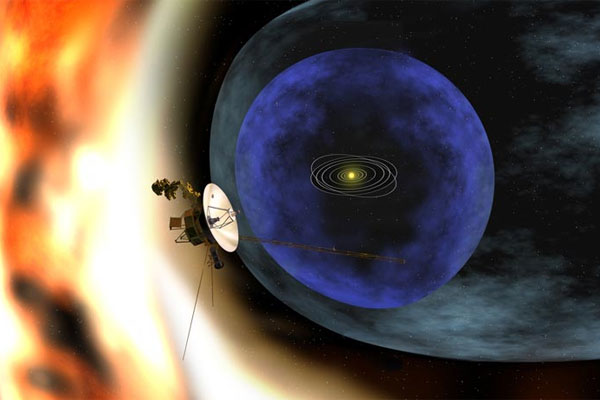From the Edge

Voyager Project Scientist
Winds of charged particles race outwards from the sun at 300,000 miles per hour. They are so faint that, here on the outer edge of the solar system, they would be undetectable if it were not for the very sensitive instruments carried by spacecraft.
From this distant, dark void, the sun is 100 times farther away than it is from Earth. Even so, our star is a million times brighter than Sirius, the brightest star seen from Earth. All around is a near-perfect vacuum, with only the most capable of instruments able to detect an ambient magnetic field that is 200,000 times weaker than the field back on Earth. To top off the loneliness factor, nothing from Earth has ever journeyed this far from home.
This remote zone is the domain now for Voyager 1 and 2.After 31 years of exploration, the twin spacecraft are the elder statesmen of space exploration, robotic envoys in the most distant reaches of our solar system. Voyager 1 is now 107 times farther from the sun than Earth is; Voyager 2 is 87 times farther. It takes about 15 hours for a signal leaving Earth to reach Voyager 1. (By contrast, it takes a little more than 20 minutes for a signal to go to Mars, even when the red planet is farthest from Earth.)

This artist’s rendering depicts NASAs Voyager 2 spacecraft as it studies the outer limits of the heliosphere - a magnetic ‘bubble’ around the solar system that is created by the solar wind.
The twin spacecraft do not rest on the laurels of their discoveries at Jupiter, Saturn, Uranus and Neptune - the planets they flew by between 1977 and 1989. In fact, their findings at our solar system’s edge are changing scientists’ theories about what happens “way out there” and how interstellar space affects our solar system.
The Voyagers have shown that the heliosphere - the sun’s protective bubble surrounding our solar system — is not smooth and symmetric, as was originally thought. The robotic team discovered that this bubble is being pushed in and deformed by the pressure from the interstellar magnetic field outside our solar system. Another surprise came when the spacecraft passed an important milestone near the edge of the solar system, called the termination shock. The energy released from the sudden slowing of the sun’s supersonic wind had an unexpected outcome - it was absorbed not by the wind itself, but by ionized atoms that had come from outside our solar system. And inevitably, as theories are shattered in the wind, more questions arise. There are cosmic rays we know come from this distant region, for example, but their origin is yet to be found and explained.
After all this time, Voyager’s discoveries continue to do what they have always done - take us to new places we have never been, and shed light on the how our solar system interacts and interconnects with the surrounding regions of the Milky Way.
Both Voyagers have enough power to run until 2025. Voyager 1 will probably cross into interstellar space by about 2015. At that moment, Voyager 1 will become Earth’s first interstellar spacecraft, leaving the sun behind as it enters the interstellar wind produced by the supernova explosions of other stars.
Until their final transmissions — hopefully many years in the future — the Voyagers still have a long way to go and lots to tell us.




















